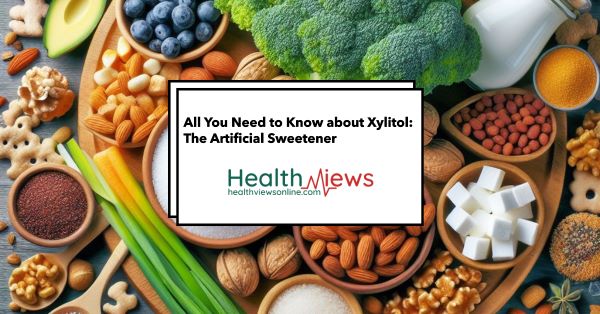In the world of processed foods, the desire for sweetness without the added calories has led to the widespread use of artificial sweeteners. Xylitol, a sugar alcohol, has gained popularity as a low-calorie alternative to sugar. However, questions have been raised about its safety and potential health effects. This article aims to provide a comprehensive understanding of Xylitol, including its definition, sources, applications, associated risks, regulatory status, and strategies for minimizing exposure. (Source)
What is Xylitol – Artificial Sweetener?
Xylitol is a sugar alcohol derived from xylose, a natural sugar found in various fruits and vegetables. It is commonly used as a sugar substitute due to its sweet taste and low-calorie content. Xylitol has a similar sweetness level to sucrose (table sugar) but with approximately 40% fewer calories. (Source)
What are the Sources of Xylitol:
Xylitol occurs naturally in small amounts in fruits and vegetables such as berries, plums, and corn. However, the majority of Xylitol used in processed foods is produced through the hydrogenation of xylose extracted from birch wood or corncobs. (Source)
What is the List of Foods Containing Xylitol?
Xylitol can be found in a variety of processed foods and beverages, including:
- Sugar-free or “diet” soft drinks
- Sugar-free chewing gum and mints
- Sugar-free desserts and candies
- Low-calorie or “diet” yogurts
- Sugar-free condiments and salad dressings
- Sugar-free baked goods
- Some pharmaceuticals and dietary supplements
Why is Artificial Sweetener Xylitol Used in the Food Industry? What are the Applications
Xylitol serves as a versatile sweetener in the food industry by:
- Providing sweetness with minimal caloric contribution, making it suitable for low-calorie and sugar-free products.
- Enhancing flavor profiles and improving palatability in various food and beverage formulations.
- Extending the shelf life of products by reducing the need for traditional sugars, which can promote microbial growth and spoilage.
- Appealing to consumers seeking reduced-calorie or sugar-free alternatives to traditional sweetened products.
The Risky and Harmful side effects of Xylitol on Human Health are:
While Xylitol is generally considered safe for consumption, excessive intake may lead to adverse effects, including:
- Gastrointestinal discomfort: Ingesting large amounts of Xylitol may cause digestive issues such as bloating, gas, or diarrhea, particularly in individuals with sensitive digestive systems. (Source)
- Hypoglycemia: Xylitol can lower blood sugar levels, posing a risk of hypoglycemia (low blood sugar) in individuals with diabetes or insulin resistance. (Source)
- Liver toxicity: In rare cases, high doses of Xylitol have been associated with liver damage, particularly in dogs, who are more sensitive to its effects. (Source)
What are the FDA regulations for Artificial Sweetener Xylitol?
The U.S. Food and Drug Administration (FDA) regulates the use of Xylitol as a food additive and considers it Generally Recognized as Safe (GRAS) when used within specified limits. The FDA sets strict guidelines for the allowable levels of Xylitol in food and beverage products to ensure consumer safety. (Source)
List of Diseases Associated with High Xylitol Levels:
Consuming excessive amounts of Xylitol may lead to various health concerns, including:
- Hypoglycemia: In individuals with diabetes or insulin resistance, high doses of Xylitol may cause dangerously low blood sugar levels, leading to symptoms such as dizziness, confusion, and fainting. (Sources)
- Gastrointestinal issues: Excessive intake of Xylitol may result in gastrointestinal discomfort, including diarrhea and abdominal pain, particularly in sensitive individuals.(Source)
- Liver toxicity: In rare cases, high doses of Xylitol have been associated with liver damage, although the risk is low when consumed in moderation. (Source)
How to Minimize the Exposure to Artificial Sweetener Xylitol?
To minimize potential risks associated with Xylitol consumption, consider the following recommendations:
- Read food labels carefully and be aware of products containing Xylitol, particularly if you have diabetes or insulin resistance.
- Limit consumption of foods and beverages sweetened with Xylitol and opt for naturally sweetened alternatives when possible.
- Be mindful of portion sizes and moderate your intake of Xylitol-containing products to reduce the risk of gastrointestinal discomfort.
- Keep Xylitol-containing products out of reach of pets, as it can be toxic to dogs even in small amounts.
In conclusion, Xylitol offers a low-calorie alternative to traditional sugars in many processed foods and beverages, but its safety and potential health effects warrant careful consideration. By understanding its sources, applications, associated risks, and regulatory considerations, consumers can make informed choices to promote their health and well-being.

Also, read: Different Types of Sugar-Free Sweeteners You Need to Know Now
Sources and References:
- U.S. Food and Drug Administration (FDA)
- European Food Safety Authority (EFSA)
- National Institutes of Health (NIH)
- World Health Organization (WHO)
- Food and Agriculture Organization of the United Nations (FAO)
- Scientific journals and peer-reviewed research articles.




